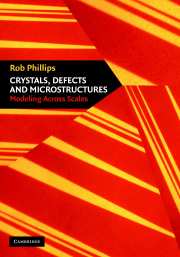Book contents
- Frontmatter
- Contents
- Preface
- Acknowledgements
- Notes on Units, Scales and Conventions
- Part One Thinking About the Material World
- Part two Energetics of Crystalline Solids
- 4 Energetic Description of Cohesion in Solids
- 5 Thermal and Elastic Properties of Crystals
- 6 Structural Energies and Phase Diagrams
- Part three Geometric Structures in Solids: Defects and Microstructures
- Part four Facing the Multiscale Challenge of Real Material Behavior
- References
- Index
4 - Energetic Description of Cohesion in Solids
Published online by Cambridge University Press: 29 October 2009
- Frontmatter
- Contents
- Preface
- Acknowledgements
- Notes on Units, Scales and Conventions
- Part One Thinking About the Material World
- Part two Energetics of Crystalline Solids
- 4 Energetic Description of Cohesion in Solids
- 5 Thermal and Elastic Properties of Crystals
- 6 Structural Energies and Phase Diagrams
- Part three Geometric Structures in Solids: Defects and Microstructures
- Part four Facing the Multiscale Challenge of Real Material Behavior
- References
- Index
Summary
The Role of the Total Energy in Modeling Materials
A recurring theme in the study of materials is the connection between structure and properties. Whether our description of structure is made at the level of the crystal lattice or the defect arrangements that populate the material or even at the level of continuum deformation fields, a crucial prerequisite which precedes the connection of structure and properties is the ability to describe the total energy of the system of interest. In each case, we seeka function (or functional) such that given a description of the system's geometry, the energy of that system can be obtained on the basis of the kinematic measures that have been used to characterize that geometry. As we have discussed earlier (see chap. 2), the geometry of deformation may be captured in a number of different ways. Microscopic theories are based upon explicitly accounting for each and every atomic coordinate. Alternatively, a continuum description envisions a sort of kinematic slavery in which the motion of a continuum material particle implies the associated evolution of large numbers of microscopic coordinates.
From the standpoint of microscopic theories, the computation of the total energy requires a description in terms of the atomic positions. In this instance, we seeka reliable function Etot({Ri}), where {Ri} refers to the set of all nuclear coordinates and serves to describe the geometry at the microscale. For a more complete analysis, this picture should reflect the electronic degrees of freedom as well.
- Type
- Chapter
- Information
- Crystals, Defects and MicrostructuresModeling Across Scales, pp. 149 - 209Publisher: Cambridge University PressPrint publication year: 2001



